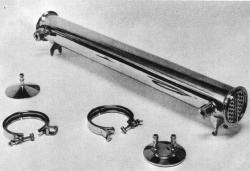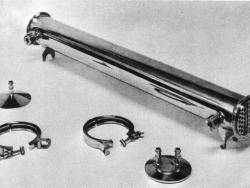This is the first commercial, human-blood heat exchanger. Developed in 1957, it permitted a patient's body temperature to be safely and rapidly lowered during open heart surgery to any desired and precisely controlled hypothermic level, then during the conclusion of the operation rapidly rewarmed to normal. Prior to this, hypothermic surgery required hours of preoperative, hard-to-control, external emersion cooling and postoperative rewarming.
Its design was a cooperative development between researchers at the Duke University Medical Center led by Dr. Ivan W.
Emmons

YearAdded:
Image Credit: Courtesy ASMEImage Caption: A disassembly of the Blood Heat ExchangerEra_date_from: 1957
1980
Innovations

This is the first commercial, human-blood heat exchanger. Developed in 1957, it permitted a patient's body temperature to be safely and rapidly lowered during open heart surgery to any desired and precisely controlled hypothermic level, then during the conclusion of the operation rapidly rewarmed… Read More


